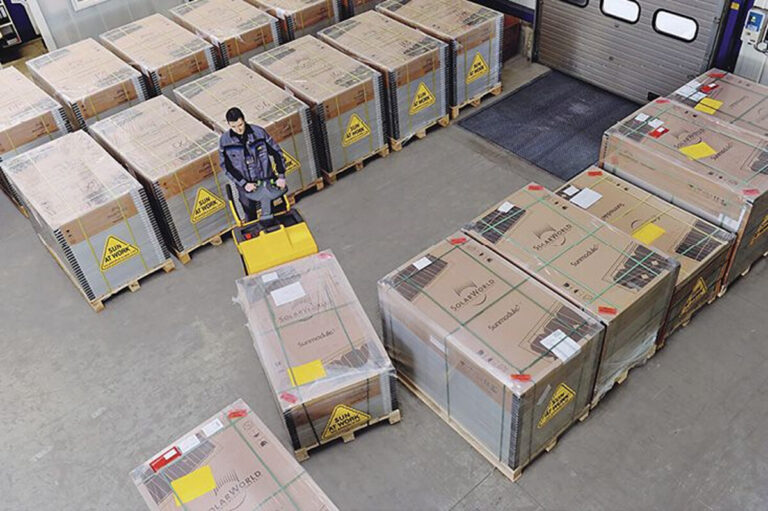The demands of measures such as the Uyghur Forced Labor Prevention Act (UFLPA) ensure that solar panel prices in the United States can be twice as high as in Europe.
The production of PV modules has increased enormously in the past two years. Clean Energy Associates (CEA) expects a 15% increase in annual solar production capacity through May 2025, versus approximately 8% higher demand.
Several factors have contributed to this imbalance. The prospect of additional anti-dumping and countervailing duties (AD/CVDs) from the US government, potentially affecting new countries, further complicates the picture for solar buyers.
With elections scheduled for November 2024 in the United States, there could be further political unrest.
Rate changes
Developers have enjoyed falling prices for the first time in a while, but new tariffs could push up U.S. prices despite abundant supply.
The world’s largest solar module makers are meeting UFLPA restrictions to ship more product than expected, and U.S. solar panel production is expanding. New manufacturers based in the United States and other countries not affected by AD/CVDs – such as Türkiye and Indonesia – would need time to adapt to the new trade policy, as happened after the introduction of the UFLPA.
Solar developers may need new suppliers and will need to double down on quality control and factory acceptance testing to ensure quality.
Technology in transition
The industry is in the midst of a transition from passivated emitter back cell (PERC) to tunnel oxide passivated contact (TOPCon) solar. Heterojunction (HJT) solar is changing, even in PERC modules, with new materials that make panels more weather resistant. Developers have historically struggled to obtain insurance for projects in hailstorm-affected areas such as Texas. Now a film can be applied to the glass of PV modules during production to strengthen products. However, such technological shifts add additional risks to supply agreements.
Favorable terms
After a 24- to 36-month seller’s market, a reversal could reopen favorable conditions for buyers. When manufacturers had the upper hand, developers struggled to convince them to be importers in good standing, and thus responsible for moving products across borders by complying with US Customs and Border Protection (CBP) UFLPA traceability requirements. When shipments are held, the importer of record is the responsible party.
If the buyer is the importer of record, he or she may be faced with paying for products stuck in customs. If the supplier is responsible, payments only need to be made once the panels are in the country.
The buyer could include a Delay Liquidated Damages clause in the delivery contract to avoid such a scenario. If a shipment is delayed because it does not meet CBP requirements at the border, the seller must reimburse the buyer for the additional costs incurred.
Developers need to ask themselves, “If I decide to fix prices, will these modules remain in the warehouses for long?” That is one of the disadvantages of planning in advance and buying at lower prices. If a project is delayed, modules sit in warehouses where they can be moved repeatedly on forklifts, potentially causing damage. However, developers can negotiate terms to limit the risks associated with long-term storage.
There is also a risk that technology will become outdated. Developers have learned the hard way in the past that when they have saved up a lot of equipment – transformers and modules – sometimes it turns out that projects are canceled or postponed long enough for the technology to evolve and their product to become obsolete. As a result, developers had to resell equipment for a fraction of the price they paid for it.
Regulatory uncertainty
Policy uncertainty poses another challenge. What will happen in the upcoming US presidential election and how will that affect the supply and production levels of solar energy equipment? Developers need to take that uncertainty into account and think about keeping their projects on track.
The current increase in supply has occurred in such a short time because of the tax breaks provided by the U.S. Inflation Reduction Act (IRA) and because manufacturers are setting up facilities in the United States to avoid import restrictions.
The world of project development and construction is currently not moving as fast as solar energy production and production. Even as challenges on the development side increase – projects are delayed, financing fails and planning regimes change – manufacturers are still moving at full speed.
The dynamics in Europe versus the United States are very different right now because of the UFLPA. There is no similar restriction yet in Europe, so the continental market is flooded with cheap modules. The price environment is in flux. Prices in Europe have fallen to as low as $0.11/W of panel generation capacity. Prices in the United States are still hovering around $0.24/W.
That price difference persists because many panel manufacturers cannot yet export to the United States as they are still trying to figure out the UFLPA import process. The industry is essentially building a differentiated North American supply chain.
Products may pass through the same facilities, but suppliers carefully separate products that require full traceability to enter the United States. Many modules located in warehouses in Europe lack the full traceability required for import into the United States.
About the author: Engilla Draper is a procurement and supply chain expert at Clean Energy Associates, which provides consulting services to developers and manufacturers in the renewable energy sector.
The views and opinions expressed in this article are those of the author and do not necessarily reflect those of the author pv magazine.
This content is copyrighted and may not be reused. If you would like to collaborate with us and reuse some of our content, please contact: editors@pv-magazine.com.


